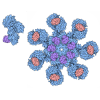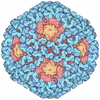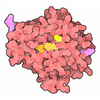+ データを開く
データを開く
- 基本情報
基本情報
| 登録情報 | データベース: PDB / ID: 9ixu | ||||||||||||
|---|---|---|---|---|---|---|---|---|---|---|---|---|---|
| タイトル | Overall reconstruction of the Bax line | ||||||||||||
 要素 要素 | Apoptosis regulator BAX | ||||||||||||
 キーワード キーワード | APOPTOSIS / Pore forming Bax proteins | ||||||||||||
| 機能・相同性 |  機能・相同性情報 機能・相同性情報T cell homeostatic proliferation / release of matrix enzymes from mitochondria / positive regulation of developmental pigmentation / BAX complex / protein insertion into mitochondrial membrane / B cell receptor apoptotic signaling pathway / positive regulation of reproductive process / positive regulation of motor neuron apoptotic process / regulation of mammary gland epithelial cell proliferation / Activation, translocation and oligomerization of BAX ...T cell homeostatic proliferation / release of matrix enzymes from mitochondria / positive regulation of developmental pigmentation / BAX complex / protein insertion into mitochondrial membrane / B cell receptor apoptotic signaling pathway / positive regulation of reproductive process / positive regulation of motor neuron apoptotic process / regulation of mammary gland epithelial cell proliferation / Activation, translocation and oligomerization of BAX / spermatid differentiation / Sertoli cell proliferation / NTRK3 as a dependence receptor / positive regulation of apoptotic DNA fragmentation / development of secondary sexual characteristics / positive regulation of B cell apoptotic process / positive regulation of mitochondrial membrane permeability involved in apoptotic process / B cell homeostatic proliferation / glycosphingolipid metabolic process / retinal cell programmed cell death / B cell negative selection / BAK complex / regulation of mitochondrial membrane permeability involved in programmed necrotic cell death / negative regulation of endoplasmic reticulum calcium ion concentration / apoptotic process involved in embryonic digit morphogenesis / mitochondrial permeability transition pore complex / Release of apoptotic factors from the mitochondria / mitochondrial fragmentation involved in apoptotic process / apoptotic process involved in blood vessel morphogenesis / post-embryonic camera-type eye morphogenesis / Transcriptional regulation by RUNX2 / apoptotic process involved in mammary gland involution / establishment or maintenance of transmembrane electrochemical gradient / positive regulation of apoptotic process involved in mammary gland involution / regulation of nitrogen utilization / B cell apoptotic process / endoplasmic reticulum calcium ion homeostasis / positive regulation of epithelial cell apoptotic process / fertilization / calcium ion transport into cytosol / epithelial cell apoptotic process / mitochondrial fusion / Bcl-2 family protein complex / myeloid cell homeostasis / motor neuron apoptotic process / execution phase of apoptosis / thymocyte apoptotic process / pore complex / hypothalamus development / positive regulation of IRE1-mediated unfolded protein response / odontogenesis of dentin-containing tooth / positive regulation of release of cytochrome c from mitochondria / TP53 Regulates Transcription of Genes Involved in Cytochrome C Release / germ cell development / apoptotic mitochondrial changes / BH3 domain binding / vagina development / negative regulation of mitochondrial membrane potential / intrinsic apoptotic signaling pathway by p53 class mediator / B cell homeostasis / positive regulation of calcium ion transport into cytosol / negative regulation of apoptotic signaling pathway / intrinsic apoptotic signaling pathway in response to endoplasmic reticulum stress / extrinsic apoptotic signaling pathway via death domain receptors / blood vessel remodeling / cellular response to unfolded protein / Pyroptosis / ectopic germ cell programmed cell death / response to axon injury / negative regulation of fibroblast proliferation / negative regulation of protein binding / ovarian follicle development / positive regulation of intrinsic apoptotic signaling pathway / extrinsic apoptotic signaling pathway / supramolecular fiber organization / response to salt stress / release of sequestered calcium ion into cytosol / extrinsic apoptotic signaling pathway in absence of ligand / Hsp70 protein binding / homeostasis of number of cells within a tissue / intrinsic apoptotic signaling pathway / TP53 Regulates Transcription of Genes Involved in G2 Cell Cycle Arrest / release of cytochrome c from mitochondria / positive regulation of release of sequestered calcium ion into cytosol / response to gamma radiation / regulation of mitochondrial membrane potential / apoptotic signaling pathway / kidney development / positive regulation of protein-containing complex assembly / cerebral cortex development / cellular response to virus / response to toxic substance / neuron migration / intrinsic apoptotic signaling pathway in response to DNA damage / cellular response to UV / nuclear envelope / positive regulation of neuron apoptotic process / retina development in camera-type eye / channel activity / regulation of apoptotic process 類似検索 - 分子機能 | ||||||||||||
| 生物種 |  Homo sapiens (ヒト) Homo sapiens (ヒト) | ||||||||||||
| 手法 | 電子顕微鏡法 / 単粒子再構成法 / クライオ電子顕微鏡法 / 解像度: 3.19 Å | ||||||||||||
 データ登録者 データ登録者 | Zhang, Y. / Tian, L. / Ge, X. / Huang, G. / Shi, Y. | ||||||||||||
| 資金援助 |  中国, 3件 中国, 3件
| ||||||||||||
 引用 引用 |  ジャーナル: Science / 年: 2025 ジャーナル: Science / 年: 2025タイトル: Structural basis of BAX pore formation. 著者: Ying Zhang / Lu Tian / Gaoxingyu Huang / Xiaofei Ge / Fang Kong / Pengqi Wang / Yige Xu / Yigong Shi /  要旨: During apoptosis, cytosolic BAX monomers are translocated to the mitochondria to permeabilize the outer membrane. Here, we identified a dimer of BAX dimers as the basic repeating unit of its various ...During apoptosis, cytosolic BAX monomers are translocated to the mitochondria to permeabilize the outer membrane. Here, we identified a dimer of BAX dimers as the basic repeating unit of its various oligomeric forms: arcs, lines, and rings. Cryo-electron microscopy structure of the BAX repeating unit at 3.2-angstrom resolution revealed the interactions within and between dimers. End-to-end stacking of the repeating units through the protruding α9 pairs yielded lines, arcs, polygons, and rings. We structurally characterized the tetragon, pentagon, hexagon, and heptagon, which comprise 16, 20, 24, and 28 BAX protomers, respectively. Missense mutations at the BAX inter-protomer interface damage pore formation and cripple its proapoptotic function. The assembly principle of the various BAX oligomers reported here provides the structural basis of membrane permeabilization by BAX. | ||||||||||||
| 履歴 |
|
- 構造の表示
構造の表示
| 構造ビューア | 分子:  Molmil Molmil Jmol/JSmol Jmol/JSmol |
|---|
- ダウンロードとリンク
ダウンロードとリンク
- ダウンロード
ダウンロード
| PDBx/mmCIF形式 |  9ixu.cif.gz 9ixu.cif.gz | 121.5 KB | 表示 |  PDBx/mmCIF形式 PDBx/mmCIF形式 |
|---|---|---|---|---|
| PDB形式 |  pdb9ixu.ent.gz pdb9ixu.ent.gz | 89.6 KB | 表示 |  PDB形式 PDB形式 |
| PDBx/mmJSON形式 |  9ixu.json.gz 9ixu.json.gz | ツリー表示 |  PDBx/mmJSON形式 PDBx/mmJSON形式 | |
| その他 |  その他のダウンロード その他のダウンロード |
-検証レポート
| 文書・要旨 |  9ixu_validation.pdf.gz 9ixu_validation.pdf.gz | 399.5 KB | 表示 |  wwPDB検証レポート wwPDB検証レポート |
|---|---|---|---|---|
| 文書・詳細版 |  9ixu_full_validation.pdf.gz 9ixu_full_validation.pdf.gz | 414.6 KB | 表示 | |
| XML形式データ |  9ixu_validation.xml.gz 9ixu_validation.xml.gz | 14.1 KB | 表示 | |
| CIF形式データ |  9ixu_validation.cif.gz 9ixu_validation.cif.gz | 20.9 KB | 表示 | |
| アーカイブディレクトリ |  https://data.pdbj.org/pub/pdb/validation_reports/ix/9ixu https://data.pdbj.org/pub/pdb/validation_reports/ix/9ixu ftp://data.pdbj.org/pub/pdb/validation_reports/ix/9ixu ftp://data.pdbj.org/pub/pdb/validation_reports/ix/9ixu | HTTPS FTP |
-関連構造データ
| 関連構造データ |  60977MC M: このデータのモデリングに利用したマップデータ C: 同じ文献を引用 ( |
|---|---|
| 類似構造データ | 類似検索 - 機能・相同性  F&H 検索 F&H 検索 |
- リンク
リンク
- 集合体
集合体
| 登録構造単位 | 
|
|---|---|
| 1 |
|
- 要素
要素
| #1: タンパク質 | 分子量: 21204.355 Da / 分子数: 8 / 由来タイプ: 組換発現 / 由来: (組換発現)  Homo sapiens (ヒト) / 遺伝子: BAX, BCL2L4 / 発現宿主: Homo sapiens (ヒト) / 遺伝子: BAX, BCL2L4 / 発現宿主:  Homo sapiens (ヒト) / 参照: UniProt: Q07812 Homo sapiens (ヒト) / 参照: UniProt: Q07812Has protein modification | N | |
|---|
-実験情報
-実験
| 実験 | 手法: 電子顕微鏡法 |
|---|---|
| EM実験 | 試料の集合状態: FILAMENT / 3次元再構成法: 単粒子再構成法 |
- 試料調製
試料調製
| 構成要素 | 名称: Bax line / タイプ: COMPLEX / Entity ID: all / 由来: RECOMBINANT |
|---|---|
| 分子量 | 実験値: NO |
| 由来(天然) | 生物種:  Homo sapiens (ヒト) Homo sapiens (ヒト) |
| 由来(組換発現) | 生物種:  Homo sapiens (ヒト) Homo sapiens (ヒト) |
| 緩衝液 | pH: 8 |
| 試料 | 包埋: NO / シャドウイング: NO / 染色: NO / 凍結: YES |
| 急速凍結 | 凍結剤: ETHANE |
- 電子顕微鏡撮影
電子顕微鏡撮影
| 実験機器 |  モデル: Titan Krios / 画像提供: FEI Company |
|---|---|
| 顕微鏡 | モデル: TFS KRIOS |
| 電子銃 | 電子線源:  FIELD EMISSION GUN / 加速電圧: 300 kV / 照射モード: FLOOD BEAM FIELD EMISSION GUN / 加速電圧: 300 kV / 照射モード: FLOOD BEAM |
| 電子レンズ | モード: BRIGHT FIELD / 最大 デフォーカス(公称値): 18000 nm / 最小 デフォーカス(公称値): 13000 nm |
| 撮影 | 電子線照射量: 50 e/Å2 フィルム・検出器のモデル: FEI FALCON IV (4k x 4k) |
- 解析
解析
| EMソフトウェア | 名称: PHENIX / バージョン: 1.17.1_3660: / カテゴリ: モデル精密化 |
|---|---|
| CTF補正 | タイプ: PHASE FLIPPING AND AMPLITUDE CORRECTION |
| 対称性 | 点対称性: C1 (非対称) |
| 3次元再構成 | 解像度: 3.19 Å / 解像度の算出法: FSC 0.143 CUT-OFF / 粒子像の数: 190916 / 対称性のタイプ: POINT |
 ムービー
ムービー コントローラー
コントローラー













 PDBj
PDBj










